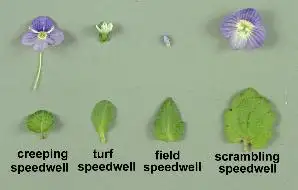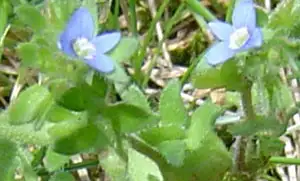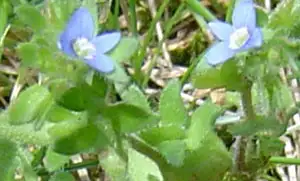Botanical name: Veronica serpyllifolia
Family name: Plantaginaceae
Overview

Turf speedwell.
As suggested by its name, turf speedwell is a weed of turf, though it can be found in pastures as well. As with all of the speedwells, it was recently moved from the Scrophulariaceae family to Plantaginaceae.
Turf speedwell is a perennial weed that has stolons that allow it to creep along the ground below the blades of the mower. When compared with the size of a pen, you can see that it is quite a small, inconspicuous weed. However, it can form quite dense mats within turf, which are not quite so inconspicuous.
It is also tolerant of many commonly used turf herbicides, so it becomes more conspicuous after spraying it with the wrong herbicide as it is one of the few weeds left in the turf.
The little white flowers which appear on the ends of the stems also help people notice it within the turf. Turf speedwell is very common within New Zealand, and seems to do best under moist conditions.
Distinguishing features

Speedwells leaf and flower comparison.
When compared with other speedwell species commonly found in New Zealand lawns, turf speedwell is the only one with a white flower, with blue streaks through it. The other three are blue with some white streaks.
The flowers of the turf speedwell and field speedwell have no stalks, unlike creeping speedwell and scrambling speedwell. Scrambling speedwell is seldom found in turf as it is a bit too large to escape the mower blades, though this is found in flower gardens and crops much more commonly than turf speedwell.
Field speedwell is smaller than turf speedwell, and so is found in turf, despite being an annual without roots along its stem to hold it below the mower blades. Turf speedwell and creeping speedwell both have stolons, with creeping stems that are rooted at regular intervals to the ground, apart from the ends of stems which don't have such roots.
The leaf shape of the turf speedwell is slightly different to the other speedwells, and the leaves are hairless, unlike the others, especially the creeping speedwell which is very hairy.
In the vegetative state, turf speedwell does look very similar to pennyroyal, with a very similar leaf shape and with stolons. To tell them apart, crush the leaf, as pennyroyal has a strong mint smell whereas turf speedwell doesn't.
Control

Turf speedwell leaves.
As mentioned above, the speedwells can be troublesome in turf because they are tolerant of most herbicides used selectively on lawns. They tolerate almost all hormone herbicides (MCPA, 2,4-D, clopyralid, dicamba, triclopyr, picloram), and speedwells are about the only weeds which survive a triclopyr/picloram mixture (Victory Gold).
Turf speedwell is best controlled using a mixture of mecoprop and ioxynil, which is available in Image. This should be applied in spring or autumn, and may need to be applied again six months later to give total control of turf speedwell.
Diflufenican (Quantum) is a cereal herbicide that gives good control of speedwells, and is now sold in New Zealand for turf weed control in a mixture marketed as Bow and Arrow NZ.











